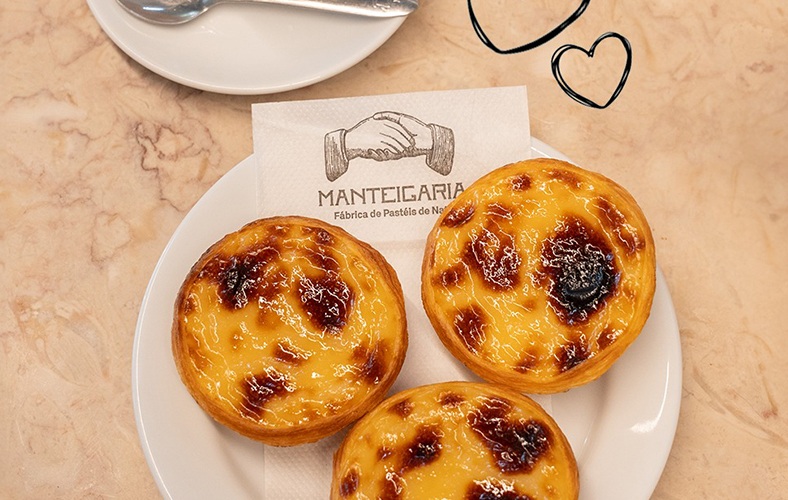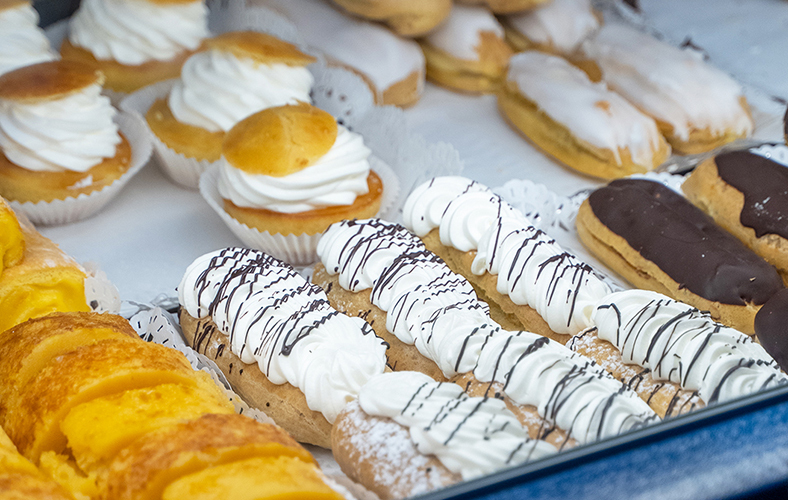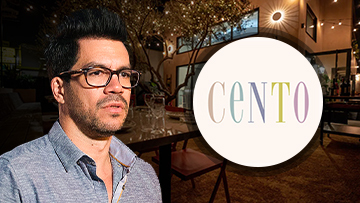The Ultimate Pasteis de Nata Showdown: Manteigaria vs. Pasteis de Belem

TL Team
Jul 29, 2025
Lisbon has a way of seducing you with its tiled charm, its hilly neighborhoods, and the golden light that hits just right at sunset. But before Tai Lopez even landed in Portugal’s capital, everyone was already whispering the same advice: "You have to try the pastéis de nata."And try them he did. But in true Tai fashion, he didn’t settle for just any pastel. He went straight to the heart of the debate that divides sweet tooths across the city: Manteigaria vs. Pastéis de Belém. This wasn’t just a taste test—this was a full-on Portuguese pastry showdown.

So, What Is a Pastel de Nata?
First things first: what exactly are we talking about here? A pastel de nata (or pastéis de nata, plural) is a Portuguese egg custard tart nestled in a crisp, flaky puff pastry shell. Warm from the oven, with a slight brûlée on top, it’s the kind of dessert that could easily become a daily habit.
These little custard bombs are eaten at all times of the day. Morning espresso companion? Check. Midday pick-me-up? Absolutely. After-dinner sweet treat? Always. Weddings, baptisms, just surviving the Lisbon hills—there’s no wrong time to pastel.
A Little History: From Monks to Mouths
The pastel de nata was born in the kitchens of the Jerónimos Monastery in Belém, sometime in the 18th century. Monks used egg whites for starching clothes, leaving yolks galore—enter custard tarts. When the monastery shut down in the 1820s, the recipe was sold to a sugar refinery, which opened Pastéis de Belém in 1837. The rest is delicious history.
Perfect For:
There’s truly no wrong time to enjoy a pastel de nata—but there are definitely some moments when it hits extra right. Here are a few of Tai’s favorite excuses to indulge:
- Hangovers: Egg yolks, sugar, flaky carbs—done.
- First Dates: You’ll both get sugar all over your faces. Bonding.
- Solo Wandering: Pocket pastry, park bench, existential thoughts.
- Late Night Sugar Hit: Manteigaria bakes late.
How to Eat One Without Getting Messy (Sorta)
If you’re going to do this, you’ve got to do it right. A pastel de nata isn’t just a pastry—it’s a full-on sensory experience. But between the silky custard that threatens to ooze out, the buttery, flaky (and slightly greasy) crust, and the cinnamon and powdered sugar that cloud the air like dessert confetti, this little tart can leave a big mess.
- Don’t wear black. The powdered sugar is relentless. It finds every surface, and dark clothes are like a beacon. Go neutral or light-colored if you care about your look.
- Shake cinnamon and powdered sugar after your first bite. This trick helps keep the first explosion of flakes contained. Plus, that first bite softens the top so your dusting actually sticks instead of flying everywhere.
- Napkins are your best friend. Grab at least three. One for your hands, one for your lap, and one for your soles when you realize how much sugar is now on your shoes.
- Buy two. One for now. One for your pocket. Yes, it sounds ridiculous. No, it’s not. The second one is always appreciated when you’re halfway through a museum and regret not grabbing another.
- Avoid eating them outside on a windy day. That gust off the Tagus River? It'll take your cinnamon and sugar and send it directly into your eyes, hair, and the person next to you. Indoor tables or a wind-sheltered bench are the move.
- Pro Tip: Stain survival. Got custard or powdered sugar on your shirt? Dab with cold water and a little lemon juice if you’re still out and about. At home, baking soda and vinegar will usually do the trick.
The Showdown Begins: Let’s Get Ready to Crumble
We’ve talked the tart, now it’s time to walk it. This is the moment Tai (and his sweet tooth) have been waiting for. Two heavyweights, one flaky crown. In one corner, the young hotshot—fast, flashy, everywhere you look. In the other, the reigning champ, steeped in history, still holding court after nearly two centuries.
Let the pastry punches fly. Let the cinnamon clouds rise. Let’s get ready to crumble.
Round 1: Manteigaria
The New Guard
Located in several spots across Lisbon (and Porto), Manteigaria is the sleek, modern contender in this sugar-dusted showdown. It’s become the name on food blogs and TikTok reels, and it's probably the pastel most tourists devour first.
Tai hit up the Bairro Alto location, where you can watch the bakers in action behind a glass wall. It's an efficient, in-and-out operation, with the smell of butter and sugar wafting onto the street.
Tai's Take: “The custard here is super creamy, way more generous than you’d expect for something this size. You bite in, and it just floods the palate."
The crust? Flaky, but not overbearing. A solid vehicle for the velvety filling. And yes, he sprinkled both cinnamon and powdered sugar on top like a seasoned local. Pro tip: don't inhale after you shake on the powdered sugar. Trust us.
Pros:
- Available across the city
- Freshly baked all day
- Buttery, rich custard
- Short wait times
- No sit-down vibe
- Less historical ambiance
- Grab your pastel to-go, then stroll through Miradouro de São Pedro de Alcântara for views over the city.
- Stop by A Brasileira for a post-tart espresso.
- Bar hop through Bairro Alto as the sun sets.
- Check out Pavilhão Chinês for quirky, vintage decor and cocktails.
- Swing by Foxtrot for a speakeasy-style vibe with strong drinks and plush seating.

Round 2: Pastéis de Belém
The OG
Located in the Belém district, this place is sacred ground for pastry lovers. Since 1837, they’ve been churning out what they call Pastéis de Belém (never nata), using the original, secret monastery recipe.
Tai took the scenic route to Belém, past the waterfront, dodging e-scooters and posing with the Monument to the Discoveries. He grabbed a box of six—strictly for review purposes, of course—and headed to the park behind Jerónimos Monastery.
Tai's Take: “There was an actual crunch when I bit into the crust. Like, you could hear it. This is next-level flaky."
The custard here is slightly firmer and less sweet, which lets the pastry shine. He doused them in cinnamon, powdered sugar, and ate them with the reverence of someone who just tasted royalty.
He even copped a t-shirt on the way out. Respect.
Pros:
- Deep history & iconic recipe
- Located in a scenic, cultural hotspot
- Perfect crust-to-custard ratio
- Indoor & outdoor seating
- Out of the way
- Tourist-heavy
- Potential for long lines (though Tai waited less than 5 minutes)
- Explore Jerónimos Monastery, a UNESCO World Heritage site with stunning cloisters and centuries of history packed into its stone walls.
- Pop into the MAAT (Museum of Art, Architecture, and Technology) for some edgy exhibits housed in a futuristic, wave-shaped building.
- Stroll along the Tagus River promenade for some sea air and photo ops with sailboats and sunsets.
- Snap a pic at the iconic Tower of Belém, a symbol of Portugal’s Age of Discoveries, and marvel at the nearby Monument to the Discoveries—it’s basically the Mount Rushmore of Portuguese explorers.
It’s mostly branding. Pastéis de nata = custard tarts in general. Pastéis de Belém = specific to the OG shop in Belém, made using the secret recipe. It's the same tart in theory, but not in execution.
Tale of the Tart: Side-by-Side Showdown
| Category | Manteigaria | Pastéis de Belém |
| Location | All over Lisbon | Only in Belém |
| Ambiance | Sleek, modern | Historic, charming |
| Crust | Flaky but soft | Ultra crispy, audible crunch |
| Custard | Creamy and rich | Firmer, less sweet |
| To-Go Efficiency | Top-tier | Surprisingly fast |
| Merch Game | Minimal | Tai-approved T-shirts |
| Instagrammability | High | Legendary |
And the Winner Is...
Cue the dramatic drumroll, the glittering crown, the slow-mo replay of Tai taking that first glorious bite. While both contenders delivered knockout performances—Manteigaria with its velvety custard and grab-it-anywhere accessibility, and Belém with its unbeatable crust and old-world charm—there can only be one king.
And that king is Pastéis de Belém.
Tai was torn, truly. But in the end, it was the history, the sensory crunch of that golden shell, and the whole immersive Belém experience that edged it out. It felt less like grabbing a snack and more like participating in a national treasure.
That said—let’s be real. These are both champions. So if you’re smart? You’ll try them both.
Can’t Get Enough? Join the Nata Crawl
If one pastel just isn't enough—and let’s be honest, it never is—Lisbon offers plenty more opportunities to indulge. Whether you're looking to continue your custard journey, explore more local bakeries, or just see how deep the tart rabbit hole goes, these spots will keep your sugar levels (and your standards) high:
- Fábrica da Nata – With multiple locations and a charming sit-down space, this one’s great if you want to relax with your pastel and a bica (espresso). Their custard leans creamy, and they serve them warm—just how Tai likes 'em.
- Confeitaria Nacional – One of the oldest pastry shops in Lisbon (founded in 1829), this place is old-school elegance. You’re here for the ambiance as much as the tart. Plus, their other pastries are worth exploring too.
- Aloma – Tucked into more residential neighborhoods, Aloma is the darling of several pastry competitions. They’ve won "best pastel de nata" more than once, and you’ll understand why after one bite.
- Padaria Portuguesa – A trendy, local chain that offers solid pastéis de nata and is super convenient. Not the most mind-blowing, but reliable, easy to find, and often served warm.
If you're loving this guide and want more on Lisbon, Porto, and beyond, make sure to check out Tai's other reviews—Portugal content is just getting started.
- Uber and Bolt are cheap and convenient, but the classic yellow trams are an iconic way to see the city and worth hopping on at least once.
- Always say yes to a pastéis offer—locals won’t steer you wrong, and it’s always the right time for a tart.
- Bairro Alto comes alive at night with music, crowds, and energy—perfect for a post-pastry adventure.
- Bring stretchy pants or a forgiving waistband—you’re going to need it after your third pastel.
Tai came, he tasted, he conquered. Both Manteigaria and Pastéis de Belém knocked it out of the park in different ways. But if he had to crown a king? It’s Belém. The history, the setting, the ridiculous crunch of that pastry shell—it all came together in a way that just felt... royal.
"It’s not just a pastry," Tai said, brushing powdered sugar off his shirt. "It’s an experience."
Best of Tailopez
-
 Ten Lazy Years Can Be Erased With Six Focused Months
Ten Lazy Years Can Be Erased With Six Focused Months -
 Why Men's Testosterone Is Half Their Grandfather's with Ben Greenfield
Why Men's Testosterone Is Half Their Grandfather's with Ben Greenfield -
 The Paradox of Wealth: Why Smarter People Aim Smaller
The Paradox of Wealth: Why Smarter People Aim Smaller -
 Mamma Mia in West Adams: Tai Lopez Finds LA's Pasta Holy Grail at Cento Pasta Bar
Mamma Mia in West Adams: Tai Lopez Finds LA's Pasta Holy Grail at Cento Pasta Bar -
 Sales Training, Scaling, and Breaking Objections: Tai Lopez with Johnny Mau
Sales Training, Scaling, and Breaking Objections: Tai Lopez with Johnny Mau

